MS Princesa Isabel Later: MTS Marco Polo, then Aquamarine, Odysseus &
Lucky Star
Click the
logo above to reach the ssMaritime FrontPage for News Updates & “Ship
of the Month”
-d-Cia.
Nacional de Nav. Costeria Autarquia Federal-d-
MS Princesa Isabel
Later
the: MTS Marco Polo, Aquamarine, Odysseus & Lucky Star
Page One
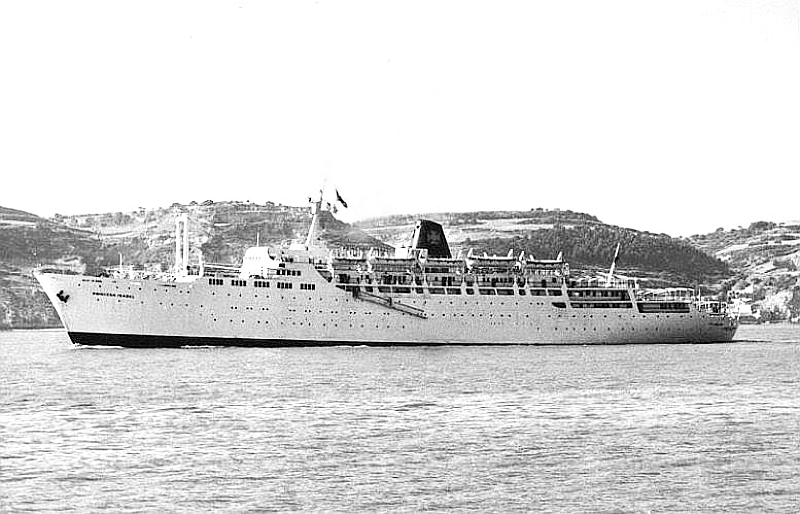
The elegant MS Princesa Isabel is seen as
built
Please Note: All photographs are from the author’s
private collection, unless mentioned otherwise!
The superbly designed sister ships, the 9,696
GRT (Gross Registered Ton) MS Princesa-Isabel and Princesa Leopoldina were built
for a Brazilian Shipping Company named; “Cia. Nacional de Nav. Costeria
Autarquia Federal” based in
The Princesa Isabel was the first to be
launched on January 18, 1961, upon completion she ran her speed trials and she
attained 17.5 knots. She was delivered to her owners in August 1962, and soon
she departed on her maiden voyage along the South American Coast between ports
on the River Amazon and the River Plate,
with ports such as; Manaus, Belem, Rio de Janeiro, Santos, Montevideo, and
Buenos Aires.
Just two months after the launching of the
Princesa Isabel the Princesa Leopoldina was launched on March 17, 1961 and in
October 1962, she commenced her maiden voyage on the identical route. The grand
total of building these two delightful ships was ten million dollars.
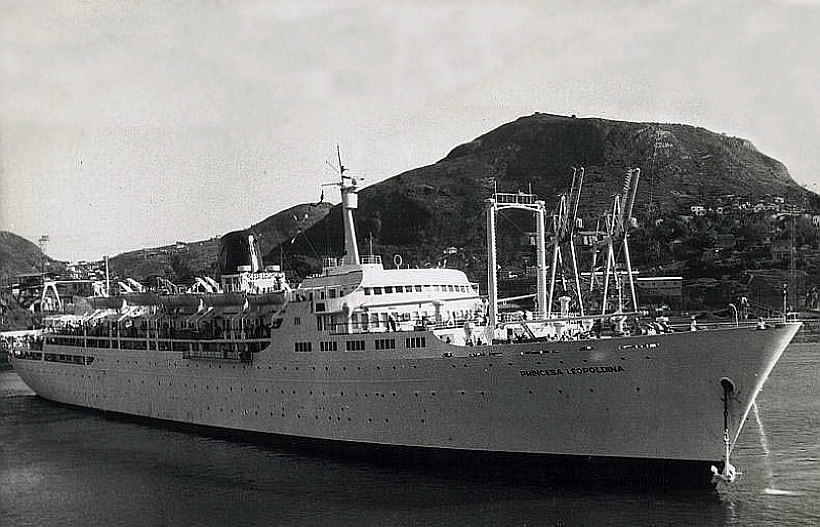
Princesa Leopoldina
As one looked at these ships were it became
immediately obvious that these ships most pleasing to the eye considering their
delightful long soft flowing lines, as well as their beautifully flared bows
combined with a well-balanced superstructure topped with a shapely modern
funnel in company colours of dark blue with the company’s traditional
yellow “La Croix Pattée” or the “Patee Cross.” Then
there was that elegant radar mast above, but located just aft of the bridge.
There were two forward cargo holds, having a capacity of a good 72,500 cu. ft.
The Company made it well known that heir lifeboats were notable considering
there were the following; 2 X 40 person’s sea boats, as well as 2 X 80
person motor boats, but also 6 X 80 person boats that had the
“Fleming” mechanically operated
Venues: There
were fine and spacious lounges, such as Main Lounge, Smoking Rooms, Library,
Card/Games Room, Bars and Dining Rooms for both classes. In addition there was
a separate swimming pool for each class as well as ample deck space, etc. These
two ships were superbly planned and executed in every sense of the word!
Troubled Times:
Since commencing their maiden voyage in 1962, their passenger loadings sadly
never reached their full potential even though their owners had high
expectations from these two fine ships! Yet for some reason, they never reached
expectations.
Therefore, it was decided to introduce a new
cruise programme and these did prove to be reasonably popular. Yet again, neither
ship ever proved to be a financially viable in the end and therefore the
company was suffering and they decided to seek new employment for them!
New Owner and Service: It was decided in 1966 that both ships would be taken over by the
Brazilian Government owned and subsidised shipping company, “Cia. de Nav.
Lloyd Brasiliero” and they were reemployed on the South American service
between Rio de Janeiro and Buenos Aires, which continued for only two further
years, until 1968.
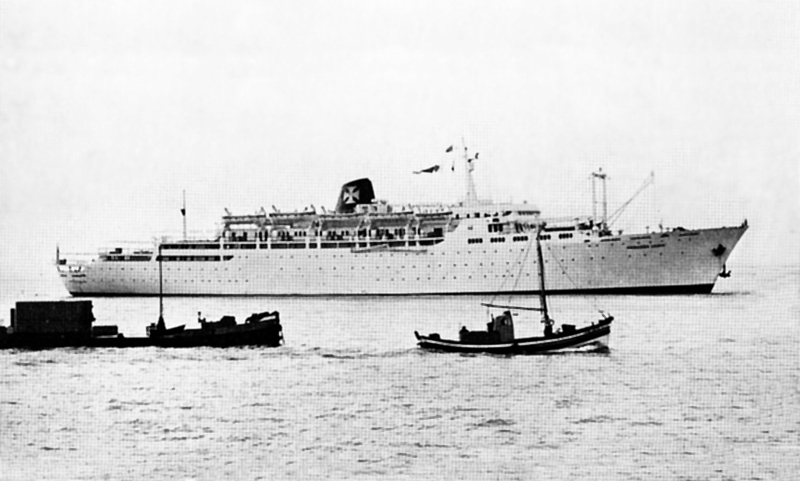
Princesa Isabel during her final days
However, passenger numbers were just never
good enough to support these two ships financially, for the problem was all too
obvious, for all passenger shipping worldwide such as the great liners to the
smaller more humble ships were all feeling the pain of the Jet travel
revolution, thus the ocean travel was rapidly being replaced by air travel and
many ships were becoming obsolete and many older ships were being sold to be
scrapped.
It was decided late in 1967 that the Princesa
Isabel would be laid up I March 1968 and placed on the market. During lay up in
the first month the company removed certain parts from the ships, such as
machinery and other parts and used them on her sister the Princesa Leopoldina.
However, late in 1969 the Princesa Leopoldina was sadly also laid up and placed
on the market.
Please Note:
The MS Princesa Leopoldina story continues on her own page! Use the link
at the bottom of this page.
MS Princesa
Isabel – Specifications – as built:
Builder: Cia. Euskalduna,
Olaveaga,
Maiden
Voyage: August 30,
1962.
Passengers: 480 / 200 in First
Class & 280 in Tourist Class.
Stabilizers: Denny-Brown
Stabilisers.
The Princesa becomes a Discoverer, the MTS Marco Polo:
Having been laid up for an extended time
finally the ‘Dominion Far East Line,’ being a joint venture with
‘John Swire’ and ‘H.C. Sleigh’ in
Her interiors received contemporary and a stylish modern décor. All her cabins and public venues received the best facilities as well as new furnishings that were of the highest quality! All five-passenger decks received new names, commencing from topside with Boat Deck, Promenade, Ivory, Jade and Topaz Deck. She now had two spacious Deluxe Suites, single, twin, triple and four berth cabins.
Upon completion, her passenger capacity had been reduced to just 375, thus she was now a far more spacious cruise ship than ever before, and even compared to any other ship of her size. Having been renamed Marco Polo, she was the very first ship to carry this name since the Adriatica Lines SS Marco Polo, which they purchased in 1936 and was broken up in 1950.
The delightful looking all new MTS Marco Polo departed the Clyde, Scotland under the British flag and she sailed without any passengers via the Cape for her delivery voyage to Melbourne Australia where she arrived in June 1970.
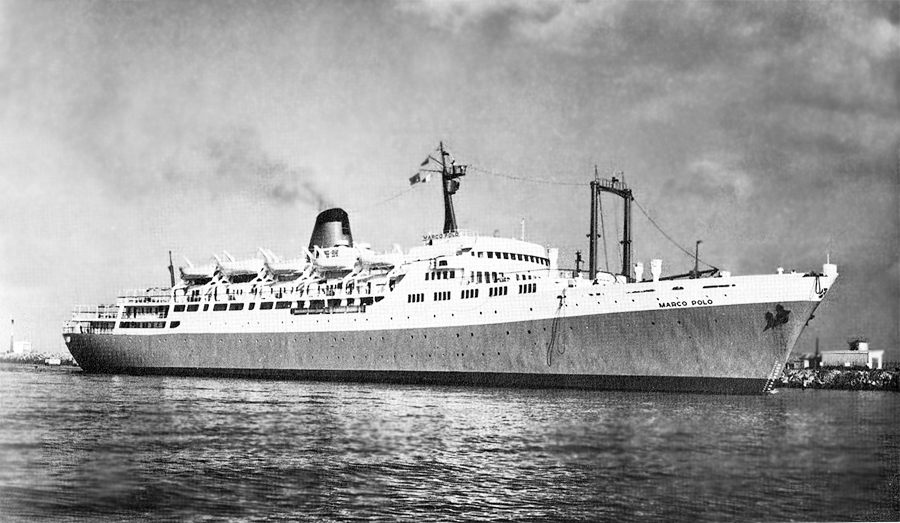
Here we
see the all-new MTS Marco Polo arriving in a port whilst she was en route to
Photographer unknown – *Please read the Photo
notes at the bottom of the page!
Upon arrival, she was fully stored and stocked
up and made ready for her new role and she departed for her maiden Australian
cruise to the Pacific on June 26, 1970. Her voyages consisted of the
ever-popular South Pacific cruises circuit as well as the extended voyages to
the
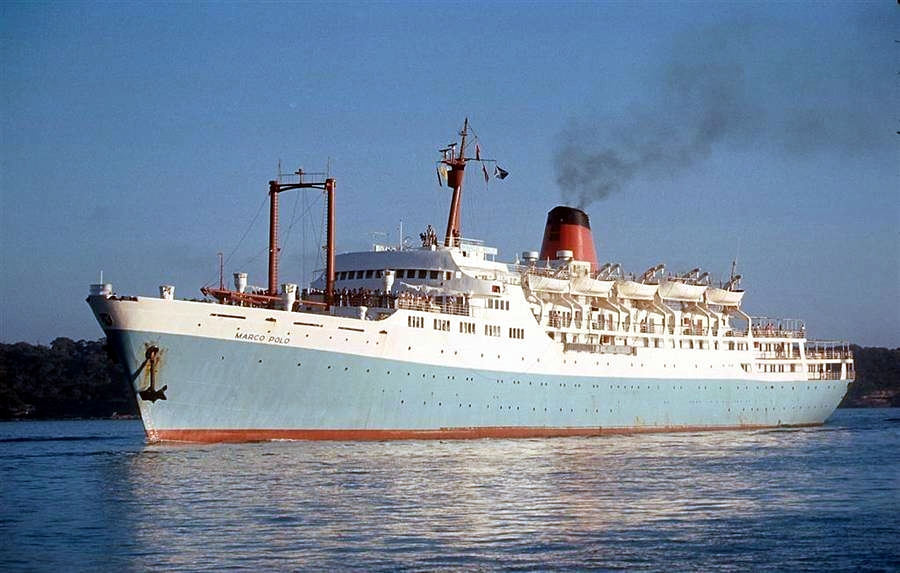
The superb looking Dominion Lines MTS Marco
Polo
Photograph by & © John Darroch
H.C. Sleigh also knew very well that the two
extremely popular Dutch ships the Royal Interocean Lines MS Tjiluwah and
Tjiwangi had been taken out of service and sold to a Singaporean Company, and
they had been very popular on the Orient service for countless years, thus they
were able to take over many of their repeat passengers with this newer larger
ship, yet still offering such a small capacity, which on a twin bedded loading
would normally be around 200 to 250 passengers at the most. And in fact this
theory worked and many did come over.
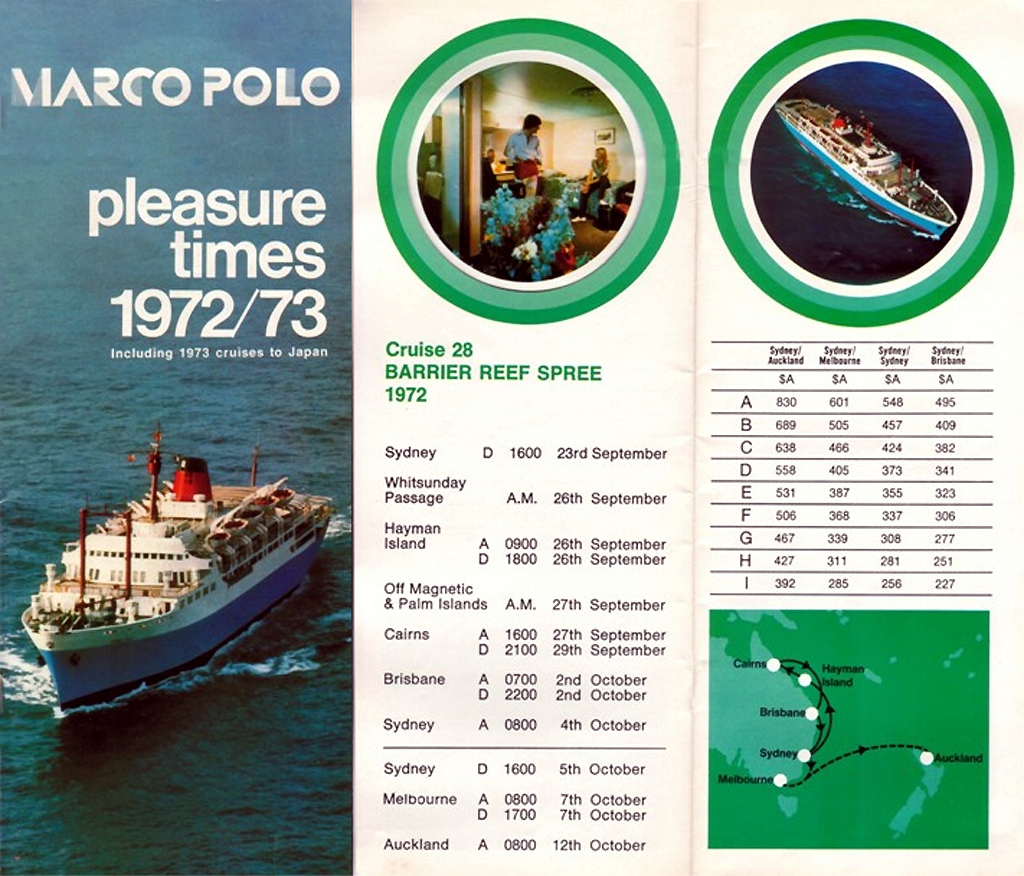
Here we see the schedule for a special
tropical
or a Sydney or Melbourne to
Of course, it should not be forgotten that Dominion/H.C. Sleigh did operate two smaller ships, which the Marco Polo in replaced, these were the two delightful 7,743 tons SS Francis Drake and the George Anson which were taken out of service in 1971 and sold to be broken up.
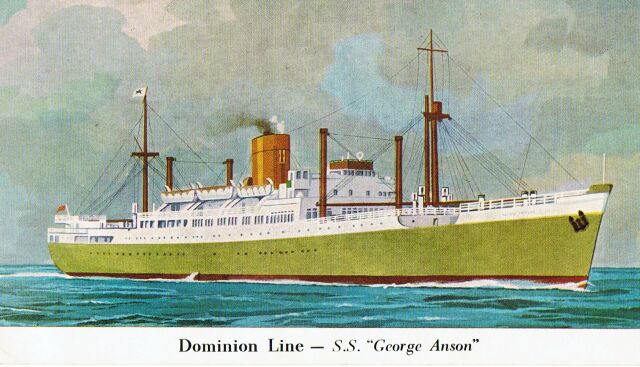
A postcard of the delightful SS George Anson
In her time, the MTS Marco Polo visited more
ports around the Pacific,
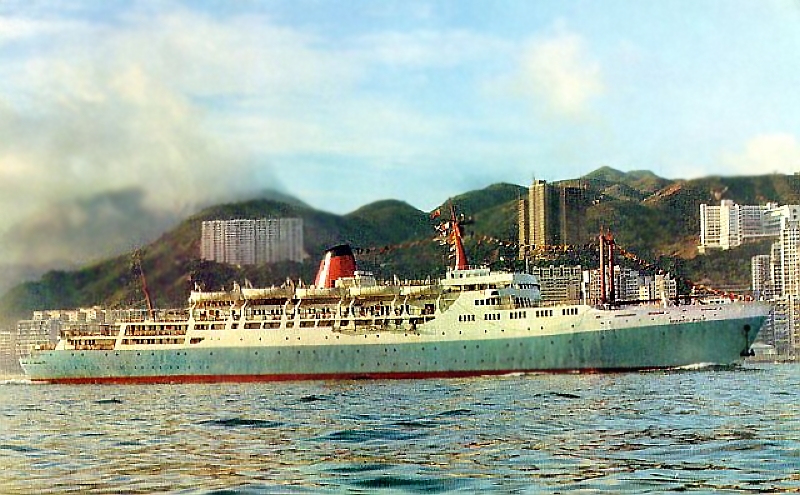
MTS Marco Polo seen in 1977
I would assume that it is needlessly to say, that by the mid seventies, the larger P&O Lines, Shaw Savill, Sitmar and CTC cruise ships, including I must say my own ship, competed in the same market, and thus the more intimate Marco Polo was beginning to find it more difficult to compete with these ships considering they offered massive promotions in Newspapers and TV with the big budgets that came with it, promoting their grand international entertainment acts from around the world, and the restaurants and buffets, etc. It all sounded so grand, even though it may not have been quite as good as the Marco Polo was in some ways! Yet her bookings remained quite good. Then without notice came a sudden announcement!
MTS Marco Polo final stormy Cruise:
After years of excellent cruise operations, Dominion Line suddenly announced in May 1978 that the Marco Polo had been sold to a Greek (Kavounides Shipping Co) owned Hong Kong Company, known as Aquamarine International. The reasoning behind the announcement was beyond my personal understanding, considering I had contacts in the company and I was told that bookings were still very good as was her advance bookings, but the head office overseas had disposed of her and then advised Australia.
Marco Polo’s final cruise departed
Her Asian itinerary included ports in
However, Marco Polo also needed to have some
injuries to be taken care of before she could continue her voyage and return to
The Marco Polo returned to
Marco Polo is sold to become the MS Aquamarine
She has an extensive refit in
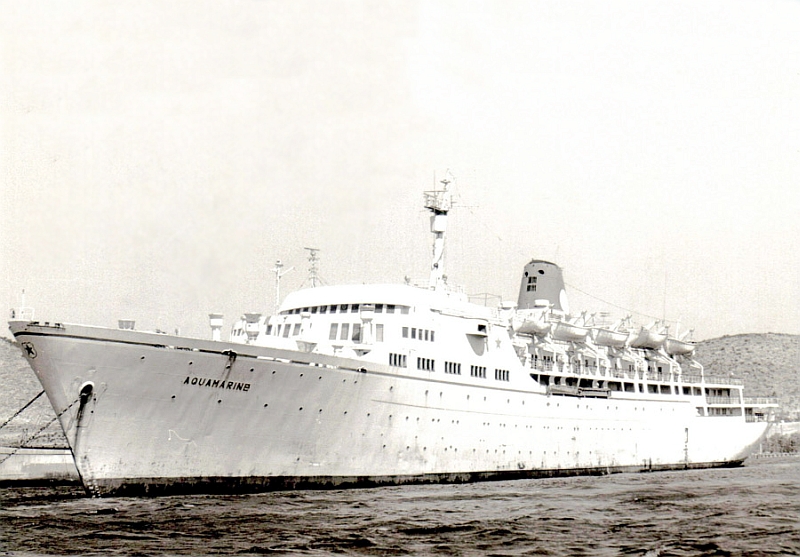
The all white MTS Aquamarine
Her new cruise schedule being Hong Kong to
Although she was in competition with her ex sister ship, which had cornered the Asian market, which was doing very well and she would operate for Swire’s China Navigation Co’s, for a good twenty long years.
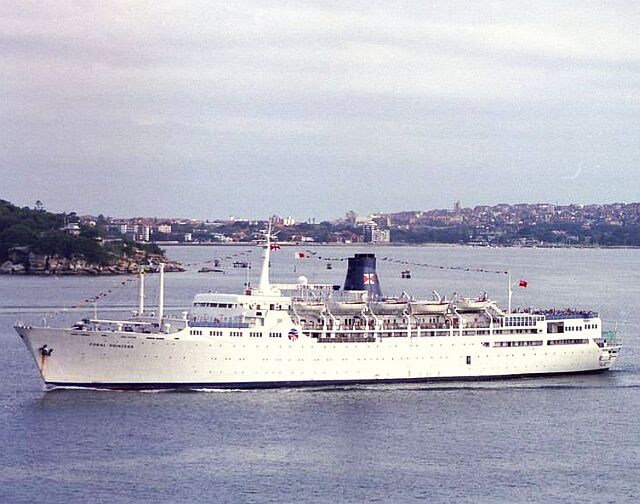
Marco
Polo’s once identical sister, the rebuilt MV Coral Princess
Change of Ownership:
Her new owner attempted to arrange a charter
agreement for her and they finally came to an agreement in October 1980, with
the Rasa Sayang Cruise Company to operate her for four years cruising out of
Her owners attempted to sell the ship, but
each attempt failed, thus they decided to bring the MTS Aquamarine
A New life as the MTS Odysseus
Having been laid up in Hong Kong and
To be continued on Page Two - see the INDEX below:
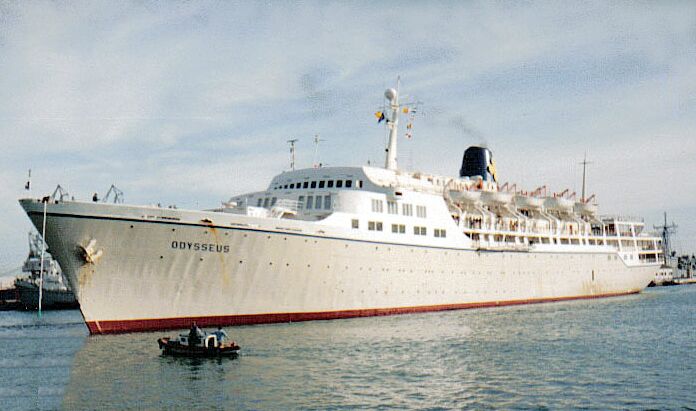
Photograph by & © Mike Godden
Page One … Princesa Isabel - Later: MTS Marco Polo, Aquamarine
& Lucky Star.
Page Two
… Odysseus, ex
Aquamarine, Marco Polo & Princesa Isabel. Later: Lucky Star & Lucky.
Page Three
… Odysseus
Photo Page & Deck Plan.
Page Four
… Princesa Leopoldina.
Later: MV Coral
Princess & Millennium Queen & Millennium.
“Blue Water Liners sailing to the distant shores.
I watched them come, I watched them go and I watched them die.”
Where you
will discover over 700 Classic Passenger & Passenger-Cargo Liners!
Where the
ships of the past make history & the 1914
built MV Doulos Story
